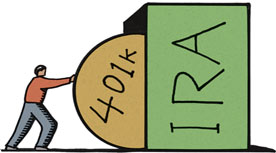
Changing or leaving your job can be hectic and even emotional time. It may not cross your mind to take care of your previous employer-sponsored retirement plan, but this is an important box to check during your transition. Don’t forget about your 401(k) or 403(b) with your previous that employer, and make sure you understand options when it comes to your retirement assets.
So how you can move money from an old employer sponsored plan such as a 401k or 403b? Essentially you have four options:
1. Leave Assets in Your Former Employer’s Plan
You can choose to leave your investments where they are when you leave your job, though you will not be eligible to continue making contributions. This is the default option if you choose to do nothing. However, if simplifying your retirement savings is your goal, this is probably not the route for you. If you leave your investments behind at each company, you’ll have various accounts to keep track of throughout your career and distributions to take from each during retirement. Keeping in touch with former employers can be difficult. Your old plan may also have high fees, limited flexibility or poor allocation options when compared with an IRA or your new employer’s plan. If your retirement account has less than $5,000, your former employer has the option of cashing you out of the plan, incurring taxes and penalties. Avoid getting cashed out by rolling the money over when you leave the company.
2. Rollover into New Employer’s Plan
A rollover is moving assets from one account to another while avoiding taxes and penalties. You can move your assets from your old employer’s plan to your new employer’s plan seamlessly without losing any money. Choosing this option is advantageous because your assets will continue to grow in a tax-advantaged account, and you won’t have to start over at each new company. You can rollover assets from a Roth 401(k) to a traditional 401(k) and vice versa, as long as both plans allow for it. If your new company has a better selection of investments or lower prices than your previous employer, it makes more sense to do a rollover. This way, you can also avoid having to keep track of old accounts with former employers.
3. Rollover into an IRA
Why would you consider this? Very simple. You have very limited investment options inside most 401ks and secondly it’s nearly impossible to have a professional manage the money, therefore, it’s left up to you. Lastly, if you need monthly income from the account you cannot take it while it’s with your old employer.
An IRA can also be more convenient, because you won’t have to worry about rolling it over again if you leave your job in the future. One feature unique to IRAs is the ability to take penalty-free distributions early (before the age of 59 ½) in order to pay for your first home or qualified higher education expenses. You’ll still pay income tax on the distributions, but you’ll avoid the fees that you’d accrue if you cashed out of an employer plan.
An IRA can also be a great vehicle for your heirs, who have the option of stretching out required minimum distributions with a traditional IRA, or avoiding them altogether with a Roth IRA.
There are two types of rollovers, whether you’re rolling your money into a new employer plan or an IRA. A direct rollover is from plan to plan. No taxes are withheld, no penalties are owed and no money crosses your hands. For an indirect rollover, your previous plan administrator writes a check to you, withholding 20 percent for taxes. You’ll have 60 days to transfer it to your new plan or IRA. If you exceed 60 days, you won’t get the 20 percent in taxes back when you file a return, and you’ll owe an additional 10 percent penalty for early withdrawals. A direct rollover is a simpler, safer route, but you’ll have to make sure you have an IRA or new employer plan established first.
Bottom line is this. By moving your old 401k or 403b to an IRA Rollover account, you have a tremendous amount of flexibility. So if you’re unhappy with either your former or current employer’s plans, an IRA may be a better bet.
4. Cash Out
This is the option least likely to be recommended to you, but it can be useful in certain circumstances. It’s important to know that cashing out a retirement plan incurs a 20 percent tax and a 10 percent penalty for early withdrawal, so you won’t actually get the amount listed in your account. If you’re truly strapped for cash, or if you’re over age 55 when you leave your employer (thus avoiding the early withdrawal penalty), you may want to consider cashing out. However, cashing out is generally not advisable. In addition to the taxes and penalties, your money will lose its tax-advantaged growth, and you may be damaging your future financial security. Cashing out in order to reinvest in a new employer plan or IRA is a costly mistake many workers make each year.
Make a Decision
Now that you know your options, you can make an informed decision about your retirement assets. Leaving your job for any reason can be stressful, but jeopardizing your retirement security would be even worse.
If you have a 401k or 403b you left behind with your old employer, let us help you evaluate your decision and what makes sense for you. Call (775) 800-1801 or visit www.sanchezwealthmanagement.com to request a complimentary review.
Jon Sanchez is a registered representative offering securities and advisory services through Independent Financial Group, LLC (IFG), a registered broker-dealer and investment advisor. Member FINRA/SIPC. OSJ Branch: 12671 High Bluff Drive Suite 200 San Diego, CA 92130. Sanchez Wealth Management, LLC and IFG are not affiliated entities. NV Insurance Lic. #3294379.